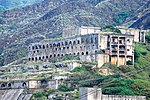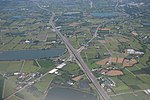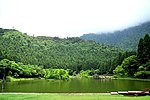World Heritage in Taiwan
The Republic of China (Taiwan) is not a member of UNESCO or a signatory to the World Heritage Convention due to the non-recognition by the majority of the UN member states . However, the country is trying to become a member of UNESCO and protect its cultural and natural assets.
Potential world heritage sites
Between 2002 and 2011, the Taiwanese Ministry of Culture identified a total of 18 sites that are potentially candidates for UNESCO World Heritage .
| image | K / N | Surname | description |
|---|---|---|---|

|
N | Datun volcanic group | The Datun volcano group is a group of around 20 former volcanoes near the northern tip of the island of Taiwan in Yangmingshan National Park . The national park is characterized by unique climatic, biogeographical and ecological features. |

|
K | Jinguashi settlement | The settlement of Jinguashi (Sied) in the Ruifang City District of New Taipei is a former gold digging and copper mining settlement . Today a gold museum reminds of the former mining. |

|
K | Fort San Domingo and the historic buildings around it , Tamsui | Fort San Domingo in the Tamsui district of New Taipei was the first fortified European settlement in Taiwan, was built by the Spanish in 1629 and rebuilt by the Dutch East India Company in 1644. Later, during the Qing Dynasty , other fortifications were added. |

|
K | Losheng Sanatorium Hospital | Losheng Sanatorium is a former hospital where lepers lived in isolation. It is a testament to controversial health policy and human rights developments in Taiwan. |

|
K | Taoyuan Plateau and Ponds | In the early 20th century, more than 8,000 ponds were created for fish farming and agriculture in Taoyuan. In Taiwan, which is otherwise poor in rivers and lakes, a new landscape and cultural traditions, some of which go back to the traditions of the indigenous people of Taiwan, were created. |

|
K |
Old mountain line railway |
The 15.9 kilometer long mountain railway was built in Taiwan during the Japanese rule and completed in 1908. It connected the mountain community Sanyi in the district of Miaoli with the community (today municipality) Houli in Taichung . Here the railway line running parallel to the west coast reached its highest point. |

|
K | Alishan Forest Railway | The Alishan Wladbahn was built in Taiwan at the time of the Japanese colonial rule and was used to transport wood that was felled in the mountains inland. It is a 72-kilometer-long narrow-gauge railway that starts in the town of Chiayi (30 m above sea level) and in the Alishan Mountains it winds up in numerous curves and tunnels to a height of 2274 meters. |

|
K | Wushantou Reservoir and Jianan's Irrigation System | The Wushantou reservoir and the associated irrigation system were built in 1930 under the direction of the Japanese hydraulic engineer Yoichi Haitta. The system represented a breakthrough in irrigation technology. Using a rotation technology, three times more land could be irrigated than with the usual systems. |

|
K | Slab houses of the Paiwan and Rukai | The Paiwan and the Rukai are two of the indigenous peoples of Taiwan. Their stone houses in Pingtung County provide an insight into the life of the mountain people of Taiwan 500 years ago. |
| N | Cypress Forests of Cilan ( Yilan and Hsinchu Counties and Taoyuan and New Taipei Cities ) | The cypress forests of Cilan cover an area of 45,000 hectares of primeval forest at a humid altitude. The forest consists of native cypress species that have been classified as "living fossils" and some trees are even more than 400 years old. | |

|
N | Taroko National Park | The national park in eastern Taiwan is the oldest national park in Taiwan. Due to the isolated location of the Tarokko Gorge there are many isolated plant species. The geological marble structure of the gorge is evidence of Taiwan's oldest geological phase. The park is now a major tourist attraction in Taiwan. |

|
N | Yushan National Park | Yushan National Park is one of Taiwan's eight national parks and is located in the Taiwan Central Mountains . It was included in the list of World Heritage candidates due to its geological peculiarities and the rich flora and fauna. |
| K | Prehistoric sites at Beinan (Taitung) and in the Dulan Mountains | The site from the middle Neolithic in Taitong City is the largest archaeological site in Taiwan with numerous architectural, biological and cultural finds. Today the National Museum of Prehistoric Culture of Taiwan is located at the site of the discovery. | |

|
K / N | "Orchid Island" Lan Yu and the culture of the dew | Orchid Island is an island off the coast of Taiwan. The Tao ethnic group has developed architectural styles that are specific to the island's weather conditions. |

|
N | Penghu Column Basalt Nature Reserve | The Penghu Nature Reserve consists of several basal stone islands that were formed by lava eruptions. It shows a landscape from the time of active volcanic eruptions off the coast of Taiwan and offers undisturbed habitat for numerous bird species. |

|
K | Penghu stone fish weirs | The Penghu fish weirs are fish traps that have been used to catch fish for centuries, taking advantage of the ebb and flow of the tide. |

|
K | Memorial sites to the fighting for Kinmen | The Kinmen archipelago, like the Matsu archipelago, was a highly fortified military outpost of Taiwan opposite the People's Republic of China during the Cold War. Today only rarely used for military purposes and accessible to tourists, the islands are evidence of the conflict between Taiwan and the People's Republic of China after 1949. |

|
K | Memorials to the battles for Matsu | The Matsu archipelago, like the Kinmen archipelago, was a highly fortified Taiwan military outpost opposite the People's Republic of China during the Cold War. Today only rarely used for military purposes and accessible to tourists, the islands are evidence of the conflict between Taiwan and the People's Republic of China after 1949. |
Individual evidence
- ^ Potential World Heritage Sites in Taiwan. In: english.moc.gov. Ministry of Culture, accessed February 7, 2019 .
- ^ Bureau of Cultural Heritage: Potential World Heritage Sites in Taiwan. Retrieved April 14, 2020 (English).


